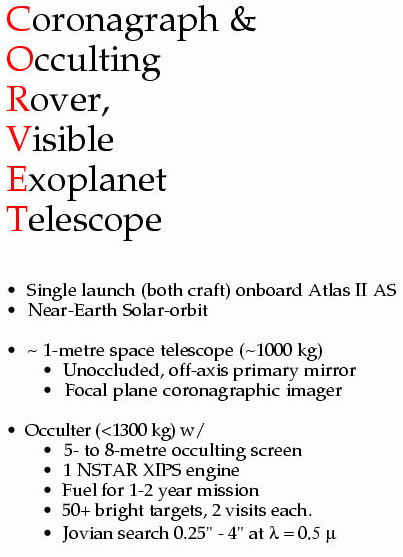CORVET (Coronagraph & Occulting Rover: Visible Exoplanet Telescope) is a concept of a medium-class explorer mission which would employ two spacecraft, a visual wavelength telescope and an external free-flying occulter, to search for nearby extrasolar planets.
| Mean Starlight Intensity Incident on Circular Centred Aperture & Angular Size of Occulter | ||||||||||||
|---|---|---|---|---|---|---|---|---|---|---|---|---|
| Distance | Screen Size | |||||||||||
| 3-metre | 5-metre | 10-metre | 15-metre | |||||||||
| Attenuation | Size | Attenuation | Size | Attenuation | Size | Attenuation | Size | |||||
| 600 km | 0.015 | 1" | ||||||||||
| 1000 km | 0.025 | 0.6" | 0.0084 | 1" | ||||||||
| 1500 km | 0.038 | 0.4" | 0.0132 | 0.67" | ||||||||
| 2000 km | 0.046 | 0.3" | 0.016 | 0.5" | 0.0041 | 1" | ||||||
| 3000 km | 0.056 | 0.2" | 0.026 | 0.33" | 0.0067 | 0.67" | 0.0027 | 1" | ||||
| 3333 km | 0.070 | 0.18" | 0.028 | 0.3" | 0.0069 | 0.6" | 0.0031 | 0.9" | ||||
| 5000 km | 0.212 | 0.125 | 0.033 | 0.2" | 0.0110 | 0.4" | 0.0046 | 0.6" | ||||
| 6667 km | 0.394 | 0.09" | 0.053 | 0.15" | 0.0135 | 0.3" | 0.0062 | 0.45" | ||||
| 10000 km | 0.652 | 0.06" | 0.173 | 0.1" | 0.0160 | 0.2" | 0.0087 | 0.3" | ||||
| 15000 km | 0.429 | 0.067" | 0.0425 | 0.15" | 0.0100 | 0.2" | ||||||
| 20000 km | 0.096 | 0.1" | 0.0192 | 0.15" | ||||||||
| 30000 km | 0.145 | 0.067" | 0.090 | 0.1" | ||||||||
One of the major factors which must be overcome is discriminating between a planet around a star and the background and diffracted light from the telescope.
The plot at right shows the contrast ratio between the ideal PSF peaks (technically, the monotonically decreasing envelope of the point-spread-function) and a Jovian planet viewed at quadrature for a 1-metre ideal telescope.
Although somewhat complex, since it involves two sets of overlapping curves, it is quite easy to use once understood. For example, suppose one wishes to find out the ratio in the brightness of a planet to the background diffracted light in the following case:
For example, a Jovian in a 5-au orbit around Altair, 16 lt-years away from our sun, would have a contrast ratio of about 9.5 magnitudes--i.e., the star's PSF is some 6500 times brighter than the planet. This is the fundamental problem in imaging extrasolar planetary systems.
The X-coordinate yields the angular separation between planet and parent star.
Planets at quadrature are the ideal time to catch and study them visibly, but planets stay at quadrature (or elongation) for very short periods of time. Nevertheless, it turns out that planets in near-circular orbits spend nearly 50% of the time at distances at least 80% of the maximum elongation distance--even for orbital planes edge-on to the line-of-sight.
 The panel at right defines the basic configuration and a typical
mission we envision.
The panel at right defines the basic configuration and a typical
mission we envision.
The basic mission parameters can be changed and optimized to increase whatever aspect is most desired. For example, changing the mission length or number of surveyable targets to increase the occulter size might be possible.
The most important feature not specified is that in order to be an efficient planet hunter, serious consideration should be given to apodizing the aperture to suppress the light in the wings of the stellar point spread function.